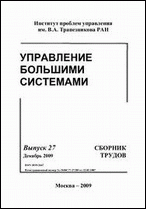|
Multi-alternativity: the evolutionary strategy of biological systems
S. Podvalny, E. Vasiljev
Voronezh State Technical University, Voronezh
Abstract:
The article describes the results of mathematical modeling and quantitative analysis of the biological properties of diversity. The aim of the work is a methodological generalization of this property of living nature in the form of a cybernetic concept of multi-alternativeity as an evolutionary strategy for the functioning of complex systems. The study of the pre-biological stage of life origin, conducted on quasi-species and sisers models, showed that for the stable existence of macromolecules capable of self-replication, they must have cross mutational flows generating a variety of competing types of molecules. Analysis of the process of molecular genetic evolution at the level of populations was carried out on the model of the Markov random process with discrete states and allowed to quantitatively substantiate the condition of intra-species evolution: the growth rate of the genetic diversity of the population must exceed the rate of occurrence of environmental conditions that threaten its existence. To model evolutionary processes in a complex multi-level ecosystem with a closed trophic cycle, differential equations of mass balance were used for each trophic level of the hierarchy, taking into account the exchange of energy with the external environment as a mass of an equivalent substance. The results of ecosystem modeling showed that when a critical event occurs in it, the diversity of species due to the redistribution of their biomass again brings the system to the trajectory of balanced growth, and the presence of a hierarchical structure as a result of the influence of interlayer feedbacks significantly speeds up this process and makes it monotonous. The results of the work formulate a number of substantive principles that make up the concept of multi-alternative: the principles of the many-leveledness, separation of functions and discreteness. The constructive nature of these principles opens the possibility of practical implementation of the multi-alternative strategy in the construction of complex control systems for various purposes.
Keywords:
mechanisms of evolution, evolutionary cybernetics, concept of multi-alternative.
Received: September 15, 2017
Published: January 31, 2019
Citation:
S. Podvalny, E. Vasiljev, “Multi-alternativity: the evolutionary strategy of biological systems”, UBS, 77 (2019), 125–170
Linking options:
https://www.mathnet.ru/eng/ubs987 https://www.mathnet.ru/eng/ubs/v77/p125
|

| Statistics & downloads: |
| Abstract page: | 187 | | Full-text PDF : | 70 | | References: | 46 |
|




 Contact us:
Contact us: Terms of Use
Terms of Use
 Registration to the website
Registration to the website Logotypes
Logotypes








 Citation in format
Citation in format 